The Ultimate Guide to SaaS Email Marketing
Email marketing is one of the most effective marketing strategies that have been used by modern companies for a long time. Emails are easy to track, send, and receive feedback on, making them useful tools to understand whether a specific marketing strategy is working or not.
To give some context about email marketing, the first email is sent in 1971 by Ray Tomlinson, who transformed modern communication. Even though there was nothing special in the email (a bunch of numbers that resembled a password), it marked the beginning of a new era for email marketing strategies.
Years later, in 1978, Gary Thuerk sent the first unsolicited mass e-mail. This was the first try at e-marketing, which gave rise to email marketing in the coming years.
Today, these developments are the reason why email marketing campaigns are a huge part of any marketing strategy, from welcome emails to customer success emails.
Even though sometimes it feels like our email folders are overflowing with spammy emails, nobody can deny the fact that email marketing has one of the highest ROI across all businesses.
What is SaaS Email Marketing?
SaaS email marketing is one of the most powerful methods to help you promote and advertise.
SaaS email marketing can take several shapes and forms, but it primarily constitutes the emails you send to paying customers or “email subscribers” for various reasons.
Each email campaign can have different goals, be targeted towards a different audience, and can leverage various layouts and writing styles.
Pro Tip: Measure Your Emails’ Effect On Adoption, MRR, Expansion, and More
Everyone sends emails, but few measure its direct impact on revenue and feature engagement.
HockeyStack is the only platform built specifically for SaaS companies.
HockeyStack allows you to unify marketing, sales, revenue, and product data so that you can uncover what drives revenue.
Here are a couple of questions that you can answer using HockeyStack:
✅Which email marketing campaign increased feature engagement the most?
✅How much revenue did a certain blog series bring us?
✅What is the activation rate of users from Facebook Ads?
✅What is the average contract value of sales that our whitepaper generated?
✅Do users that affiliates bring churn faster than users that marketing brings?
Best thing about it? It’s all no code, no setup, cookieless, and we have a free plan.
Click on the image to see a live demo of HockeyStack!

Best SaaS Email Marketing Strategies
While email marketing offers incredible ROI, it’s important to keep certain best practices in mind especially when you’re just starting off with email marketing. Here are some tips and tricks to help you get the best results from your email marketing efforts:
Segment Your Subscribers
In 2019, more than 290 billion emails were sent daily and this figure has gone up to 333 billion emails per day in 2022. With so many types of emails, it is crucial for you to develop your SaaS email marketing strategy in such a way that you can segment your emails according to your audience, their behaviors and preferences.
With segmentation, your emails can be more targeted and focused. Rather than expending your time, effort, and money to audiences that will not engage with your emails, you can get the most out of email marketing with customer segmentation. For example, if your company is organizing a product launch, sending invitation emails to people who are geographically close to the location would be a wise decision. If you send these emails, to people all around the world, they will not yield any attendees and, in turn, any new paying customers.
The best way to reach your targeted audience is to segment your subscribers/audience into different categories and send emails according to them. A successful segmentation would result in a better open rate, click rate, bounce rate, and unsubscribe rate.
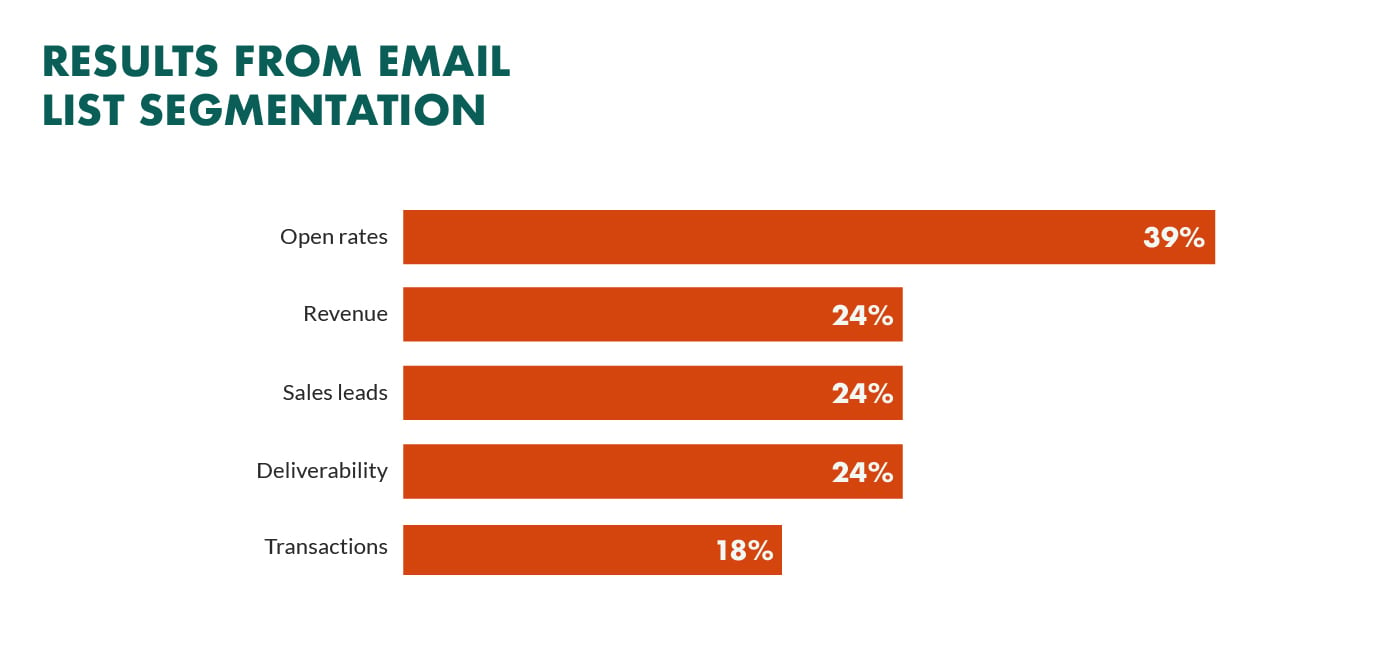
Segmentation is reliable technique that can be leveraged easily. However, there are marketers who are not segmenting their emails in the right way or not reaping the full benefit of segmentation. So, here are some ways you can segment your audience:
- By Industry: This is the simplest form of segmentation; however, it is also one of the most effective ones. Knowing the industry of your customers can give you valuable information about whether your customers will engage with your emails or not. For example, an email campaign about computer hardware would be more engaging for a business that builds computers. However, a business that sells beauty products would not engage with that same email. Therefore, segmenting can help you save time, energy, and money.
- By Company Size: In other words, segmenting your audience according to their revenue. This is especially helpful if your product/service is specifically designed for companies that are big or vice versa. So, if you deal in a product or service that requires a very large budget, sending out marketing emails to smaller companies that may not be able to afford your offering is not the best idea.
- Sales Cycle: A new subscriber would not be ready for a multi-email campaign . Similarly, an email that is basic and tutorial-like would not fit for a subscriber that has been using the product for a long time.
Choose The Right Time
The key to successful email marketing is choosing the right time to send emails. You cannot just send emails any time or day and wait for a good open rate. Like in everything, there are optimal times to send emails, which change according to the audience and their preferences.
The inbox crowding and the deployment times also have huge effects on determining the timing. For example, if you send emails at a time when few other emails are crowding your subscriber’s inbox, it will have a greater chance of being seen. However, if the time you choose is not convenient for your subscriber to open the email, your email will have a lower chance of being seen. Therefore, perfecting the timing of your emails crucial to successfully convey the message you want your recipient to see.
The best way to understand the right time for your business and subscribers is testing, testing, and testing. You may perform A/B tests to track the times your subscribers are more active and available to engage with your emails. You may also occasionally change the times you send your emails and collect data about email success rate, open rate, and bounce rate.
Here is a useful table for the most effective times to send emails according to different types of businesses:

With the help of tools like HockeyStack, you can determine the time and create strategies to ensure that your business can reap the benefits of email marketing. Such tools dive deeper into your email marketing efforts by providing you with information on how many readers took any steps such as clicking on a link or viewing a video embedded in the email for best results.
Send Emails Based On Feature Usage
If you are sending the same emails to every subscriber, chances are that you won’t get the results you’re looking for. Each subscriber should be treated individually according to their needs and behaviors. For example, some of your subscribers may need emails about tutorials. On the other hand, others may engage with emails about FAQs.
Behavior-driven emails are messages that are sent by your email service provider triggered by the user’s specific actions. In other words, you can use email automation to treat each of your customers according to their needs. You can also make use of autoresponders to reply to your customers quickly, increasing customer engagement, retention, and loyalty.
You can also send emails to your customers depending on the features they’re using. This will help you send targeted emails and increase your open rates. At the end of the day, the most important thing about email marketing is to have a high and reasonably consistent open rate. Therefore, understanding your customers’ behaviors and personalization is important for a successful email marketing strategy.
Test Different Subject Lines
The first thing your subscribers see about your email is the subject line. It determines whether your subscribers will open your email or let it pass. Therefore, understanding and choosing the most effective subject line can change a lot of things about your email marketing.
Since the subject line of your email will make the first impression on your reader, it should be concise and precise. You are not trying to convey the whole message of your email with the subject line; your aim is to intrigue your subscriber to click on your email. Therefore, your subject line shouldn’t be very long, distracting, or bore your subscribers. However, it also shouldn’t be so short that your subscriber thinks the mail is spam mail. Here is a table that compares the number of words and open rate:
| Number of Words | Open Rate |
| 0-5 | 16% |
| 6-10 | 21% |
| 11-15 | 14% |
| 16-20 | 12% |
| 21-25 | 9% |
As you can see the optimal number of words is 6-10, which is not very long or short. However, it is not the easiest thing to write the right subject with just 6-10 words. Most of the time, marketers want to use flashy sentences. However, with strong nouns and verbs, you can construct a good subject line without distracting or boring your subscriber.
While creating your subject line, you can keep in mind:
- Entice curiosity, but use simple and clear words.
- Using numbers is great strategy because they catch the eye and entice curiosity.
- Use friendly ad conversational without being cheesy.
- Show your product’s/service’s personality.
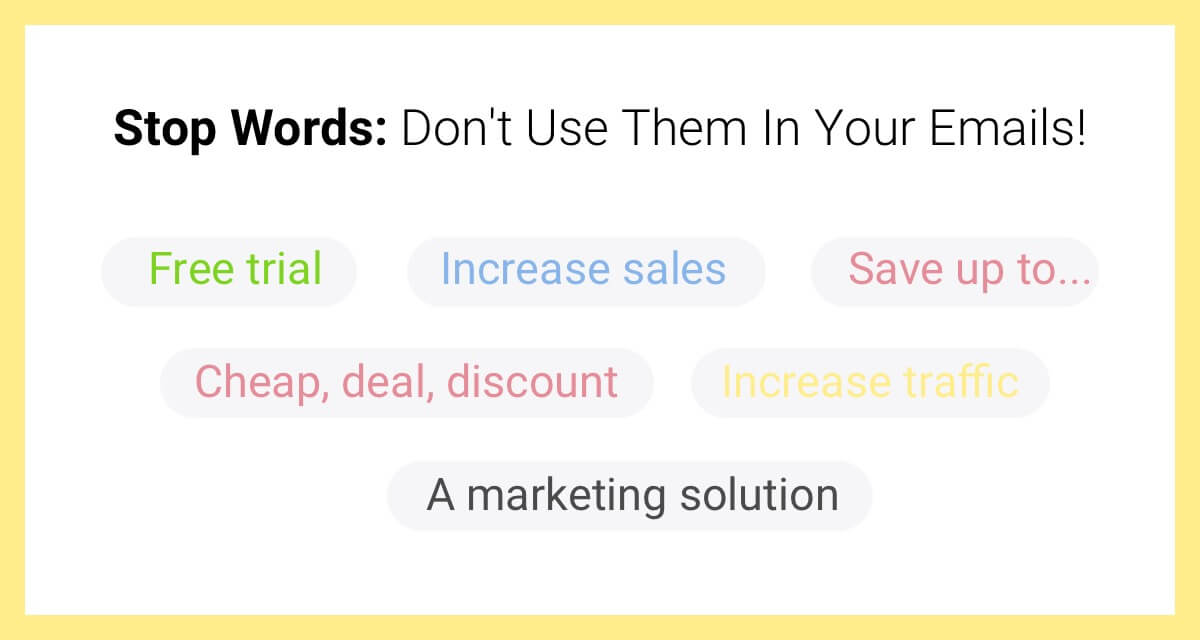
Measure Your Success
Measuring the success of your email marketing is an important aspect to understand your weaknesses and strengths. There are a lot of email marketing metrics that can help you to track, collect, and analyze data specific to emails. The most prominent ones are ROI, open rate, and click rate. These will give you a general idea about how your subscribers are reacting to your emails.
There are also other types of metrics that will give you a deeper analysis of ways in which your subscribers are engaging with your emails. For example, HockeyStack can help you to understand the optimal time, define your audience, and organize your email list through its powerful email marketing features.
Measuring success is also important to redefine and reanalyze your marketing strategies. Even though email marketing is one of the most successful marketing strategies, it may not work for your business, or sometimes you may not realize your strategy is not beneficial for you. In these cases, having data about your email marketing strategy is crucial to taking data-driven actions to enhance your marketing.
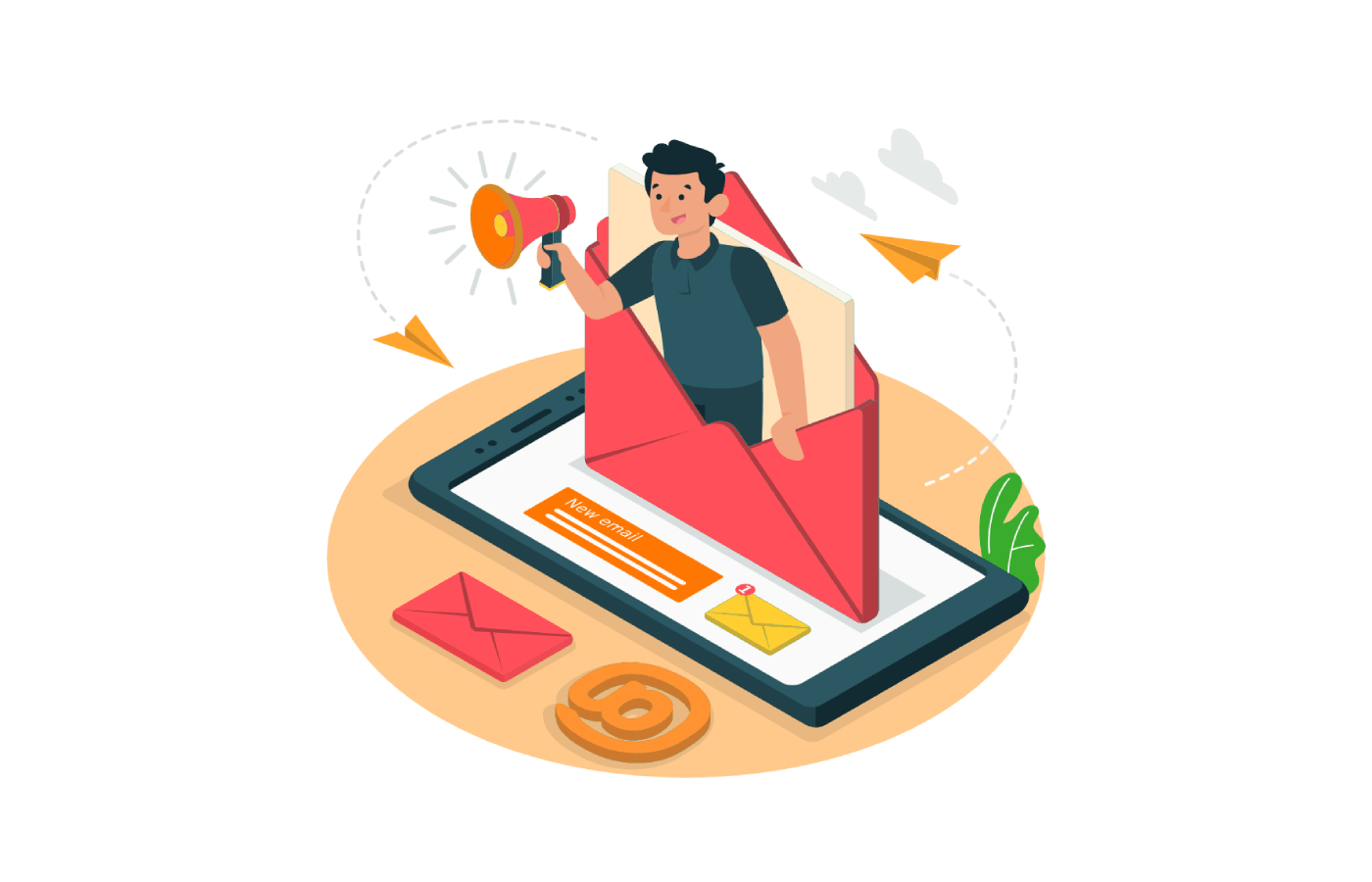
While measuring email marketing, don’t forget to look at them cohesively. Each metric helps you to solve the puzzle, contributing to the whole picture. Therefore, you may need to combine several different metrics together to comprehensively understand whether your email marketing is working or not.
Keep Track Of Inactive Subscribers
When you send marketing emails, you’ll notice inactive users who will not engage with your emails. The bounce rate is a useful metric to keep track of to identify these inactive subscribers. With this key metric, you can understand the percentage of emails that are being bounced from your recipient’s mailboxes or not being opened by them.
Defining what is inactive for you would be a good start to cleaning inactive email recipients. However, the process shouldn’t be as simple as creating a small list of people who never open your emails and removing them from your subscribers’ list altogether Once you identify inactive users, you need to try to reengage with them using a different approach to ensure that they’re really not interested in engaging with your business.
There are a lot of ways to win back your inactive subscribers through email. Here are a few you could try:
- “We-miss-you” campaigns
- Discounts, promo codes, or special offers
- Tutorials or guides
- Any type of email that is completely different than your usual emails
You should also keep in mind that sometimes no matter how hard you try, there is no way to reengage with all of your inactive subscribers. In this case, the best move to do is to clean your subscriber list. This will help you to have a more targeted audience and a refined list of subscribers.
Make It Personal
Personalization may seem an obvious strategy to nail email marketing; however, most of the time it is overlooked. Compared to non-personalized emails, personalized emails have 29% higher unique open rates and 41% higher unique click rates, indicating personalization is a huge aspect of successful email marketing.
The old strategy for personalization was to simply mention the name of the recipient, but unfortunately for businesses today, that no longer suffices. In addition, spam emails are the ones that now mention names over and over again.
Keeping an eye on some successful personalized email marketing examples and being aware of your subscribers’ behaviors, needs, and preferences is your best bet at personalization. For example, e-commerce websites can send emails according to past purchase behaviors, proposing a new product that is similar to ones that the subscriber already had bought. This is a safe and effective way to show your subscriber that their email is personalized just for them and you care about their preferences.
Personalized emails nurture the relationship between your customers and your product/service. Therefore, the time, effort, and money you spend on personalization will help you to gain the loyalty and trust of your customers. Building that kind of relationship helps you to have an active customer base, increasing your revenue and keeping your old customers satisfied.
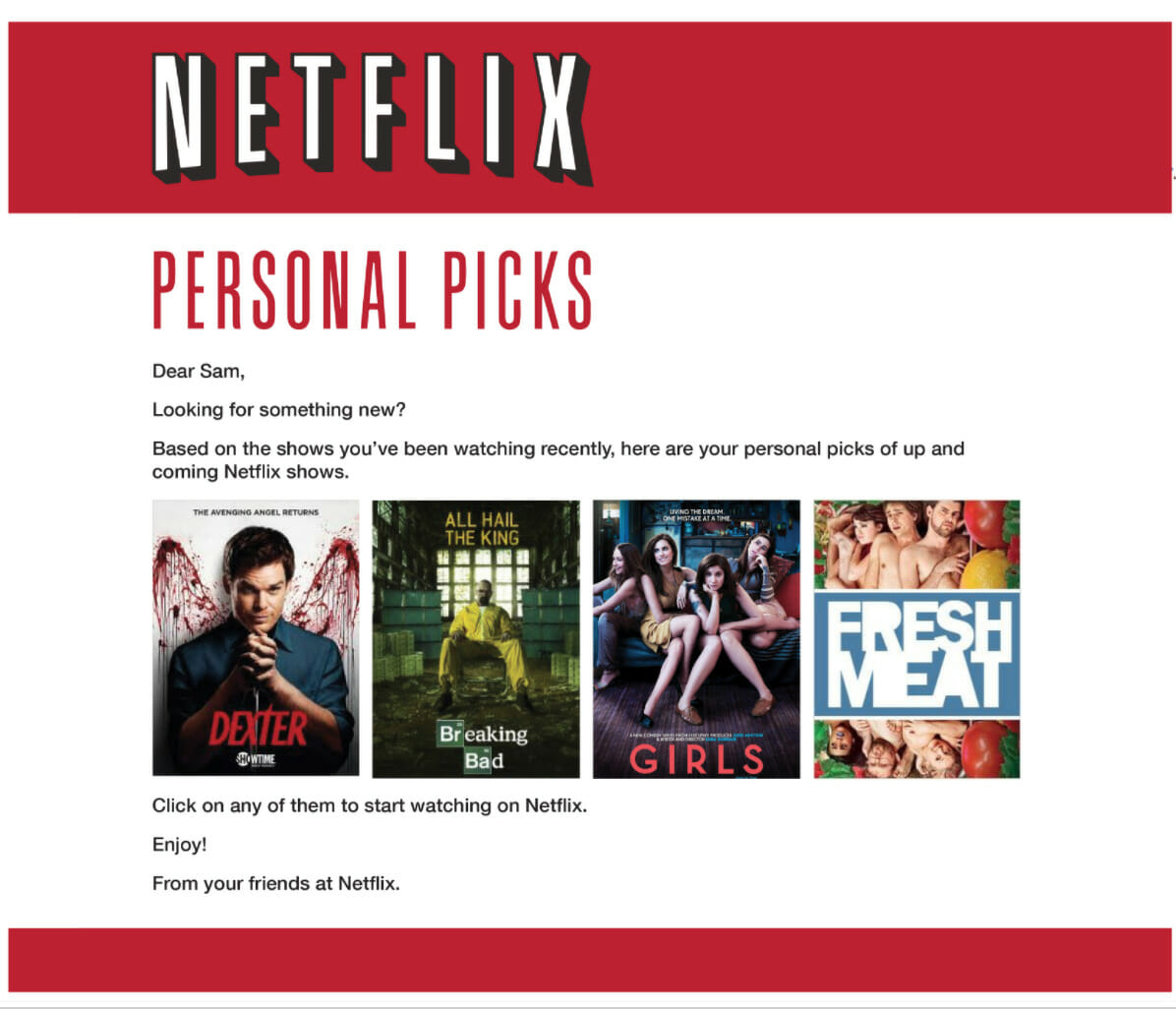
Use Branding In Your Signature
Email signature branding is the easiest and cheapest way to promote your brand through email. They create brand awareness and are known to increase engagement with your brand as a whole.
For email signature branding, you need to be first clear about what your brand’s personality is. After deciding, on all aspects that build your brand, you need to make sure that all your emails are constructed according to them. It is also important to have a cohesive set of email templates.
Here are some questions you can ask yourself while creating your email signature branding:
- Are all your company email addresses are consistent, clear, and simple?
- Which font is your primary, secondary, and tertiary font? Does everyone use the same font?
- What is your email header? How do you greet your subscribers?
- Is there a special ending to your emails?
- What aspects of your branding you want to display?

Consistency is key to a powerful email signature branding. All of your emails need to be easily recognizable with the font, messaging, and colors for your branding to be considered successful. When your subscriber opens your email, they should be certain which brand it came from. This will help you with the open rate and click rate and give you an advantage over your competitors.
How to Repurpose Content for Email Marketing Campaigns
Producing new content for your email marketing campaigns can be hard.
If you encounter this problem and have a need for constant content creation for your email marketing campaigns, you can try out repurposing the content you have created for other purposes.
Repurposing content refers to taking one piece of content that you have created for a purpose and using it in a different place. However, this does not simply mean you can copy and paste whatever you would like. The content that you repurpose needs to be suitable for the medium you are repurposing it for.
For example, consider that you have an article regarding user activation. If there is an increased demand for knowledge regarding user activation a short period after your article is written, you can make your customers aware of this article, which is already written, through an email newsletter. This means that in addition creating new content for your email marketing campaigns, you will also be able to get more exposure to your existing content.
Repurposing content for your email marketing campaigns is vital for SaaS businesses. Most of the professional companies in the field use this method as a part of their email marketing strategy. Here are some of the ways that you can repurpose your content for your SaaS email marketing:
1. Create a Newsletter That is Flexible
One of the most vital parts of SaaS email marketing campaigns is the newsletters. Most of the companies in the field rely on them to reach out to their customers. However, you need your newsletter to be as flexible as possible. If your newsletter draws the attention of your target audience based on one certain aspect, you might fail to reach out to your customers.
2. Share Content That Is Created By Your Users
Repurposing your content is especially useful for your Saas email marketing campaign if you utilize content created by users. By using content created by your users, you will not only be able to increase the reach of your email newsletter but will also save yourself from the hassle of creating new content.
3. Combine Your Existing Content
When you are repurposing the existing content that you have, you are not limited to simply copying and pasting the existing content. You can combine several smaller pieces of existing content into long form content, like an ebook, to increase the reach of your SaaS email marketing campaign.
In addition to creating e-books, you can provide your readers with case-studies from your internal data and its existing analysis. Providing your users with conclusions derived from existing data is a great way to introduce them to the inner workings of your product.
SaaS Email Marketing Examples
Here are 25 email marketing examples from SaaS companies to inspire you:
Grammarly’s Promotional Email

A cloud-based writing assistant software, Grammarly has crafted a carefully designed email, which can be categorized as a lead nurturing email.
What do I mean by “lead nurturing?” Well, some people on your mailing list may exist in the consideration stage: they are aware of your brand and services, but they may be using the free version you had offered them, or maybe they only subscribed to your email list and have not yet gotten around to using the product or service that you’re offering.
Whichever the case, sending a promotional email like this one is likely to move them down the marketing funnel and into the decision stage, nurturing them in a sense.
There are a couple of reasons why Grammarly’s email is such a good example of this type of e-mail:
- It has a clear and concise call to action. There isn’t an overload of information about the product.
- It makes use of colorful visuals that provide useful data that convinces the reader.
- It directly addresses the user by talking about their experience.
Hootsuite’s Promotional Email

Hootsuite, a social media management platform, is reaching out to qualified leads and telling them that their brand is an expert in its field–the “speak to an expert” button serves to this purpose.
They’re also telling the reader that there’s no reason to be “daunted” by their paid features: they’re offering a free template that can be accessed right now. The email also includes a reference to a success story of the brand, which contributes to their brand image. A potential customer in their research stage will be attracted a brand that acts as a thought-leader, so this email is quite effective.
Visme’s Promotion Follow Up Email

Emails like that of the visual content platform Visme feel personal because they refer to a previous conversation. They know that e-mails get lost or ignored in the busy mailboxes of customers and that reminding them does not hurt.
Their strong hook makes the offer sound like an even better deal as if it was offered only to the reader.
If this email was sent after an appropriate amount of time had passed since the first email, then it’s pretty likely that the reader would accept the offer.
Ebay’s Discount Email

Ebay, one of the biggest e-commerce businesses, is aware of its user profile and their interests. Typical users of Ebay are searching for good deals and prices constantly, and what better way is there than directly telling them what’s going on?
This is another great example of a lead nurturing email, but there’s a small trick that Ebay is using that’s worth pointing out: there are no price tags on the products.
This is because email marketing isn’t only about getting people to buy your products, it’s also about driving meaningful traffic to your website.
Another great aspect of this email is that it’s consistent with Ebay’s design and branding. The color choice and the photos are all similar to what a lead may see on the website. The header menu is almost identical to the one on the site, too.
Brand consistency means that your leads are recognizing your brand on all of the different platforms you may be reaching them from: that’s why branding is one of the most important B2B marketing strategies.
Teespring’s Re-Engagement Email

A social platform where you can buy or sell customized products, Teespring is aware of how some subscribers eventually end up as inactive users. Their re-engagement email is targeted specifically at these users: it gives them reasons to return to their service by using personalized data. This data that acts as a past success story is a great way to lure them back to the brand.
Another characteristic of this email is that it appeals to the emotions of the viewer. There isn’t a more universal symbol of empathy than an adorable, sad-looking puppy (although you may want to use different images to apply to your viewers’ emotions, as we encounter many other emails using the same image.)
One last thing: similar to the other examples, this email is made up of only 5 to 6 sentences. It’s clear and to the point, with a giant blue button ready to be clicked on.
These may seem like small details, but they are important if you want to have a high click rate on your emails.
DropBox’s Re-Engagement Email

Dropbox’s childlike drawings and sad faces get the inactive user’s attention. In three points, Dropbox reminds users what their service is good for in a playful tone, so as not to bore the reader. It does not stuff the email with reasons to come back or with countless CTA buttons, and it still engages users and drives traffic.
Zoho Mail’s Referral Campaign Email

Perhaps one of the most underrated types of email marketing is referral campaigns. It’s mostly thought that people avoid getting into the fuss of inviting friends to get discounts, or that referrals are not taken seriously by other users, but that is simply not the case. These campaigns are highly effective because 3 main reasons:
- “Word of mouth” is the main motivation for between 20 to 50 percent of purchases, especially when the buyer is a first-timer,
- They are great tools for building brand-awareness,
- They result in excellent conversion rates and longer subscriptions (in fact, referred customers were found to be 18% more likely to stay with a brand than other customers)
This email sent by Zoho Mail is a good example of this marketing strategy: a brand offering email marketing services to companies, Zoho Mail is promising the reader up to 25 free accounts. This is a tempting deal for most businesses and the deal is also written in a big font to attract more readers. The email also makes use of minimalistic yet creative designs, and how the deal works are explained step by step at the end of the email.
There are two buttons to get the user started, one in the beginning and one at the end, so it doesn’t matter if the reader stops reading after the headline or decides to goes through the whole thing: there’s still a chance for them to click on the button and to create traffic for your website. So, even if you don’t reap all the benefits above, you’ll still get people to be aware of your services.
HeadSpace’s Survey Inquiry Email

Surveys are great tools to understand how you can improve your service so that you can decrease your churn rates. That said, the main problem might not be creating your survey, especially if you’re using a tool like Hockeystack. Getting users to fill out the survey, however, may be a lot more difficult. The users who receive your survey are likely to have a couple of questions in their minds, and this survey form from HeadSpace directly answers all of them.
A meditation app that makes use of different subscription plans, the brand addresses several issues that may arise: “Why should I take the time to answer all these questions?” Because you might get a free 3-month Headspace code. “Isn’t it just going to bore me?” Well, Headspace promises it won’t (plus it’s “super short.”) “Why would they ask me?” Because they care about your experience and want to improve themselves as a brand.
Email on Acid’s Survey Inquiry Email

Another effective email of the same kind comes from the email tracking platform Email on Acid. Similar to HeadSpace, they give the user a clear incentive (the possibility to win a 100$ gift card), but they also include details that the previous didn’t: they tell the reader just how long filling out the survey will take, and they include an urgent call to action (only the “first 100 people to complete the survey” will get a chance to win the gift card.)
These are all subtle yet effective details. Don’t just use email marketing to tell people about your products or to advertise your new features: give them a chance to interact with your brand by taking their feedback and making them feel important.
Shopify’s Welcome Email
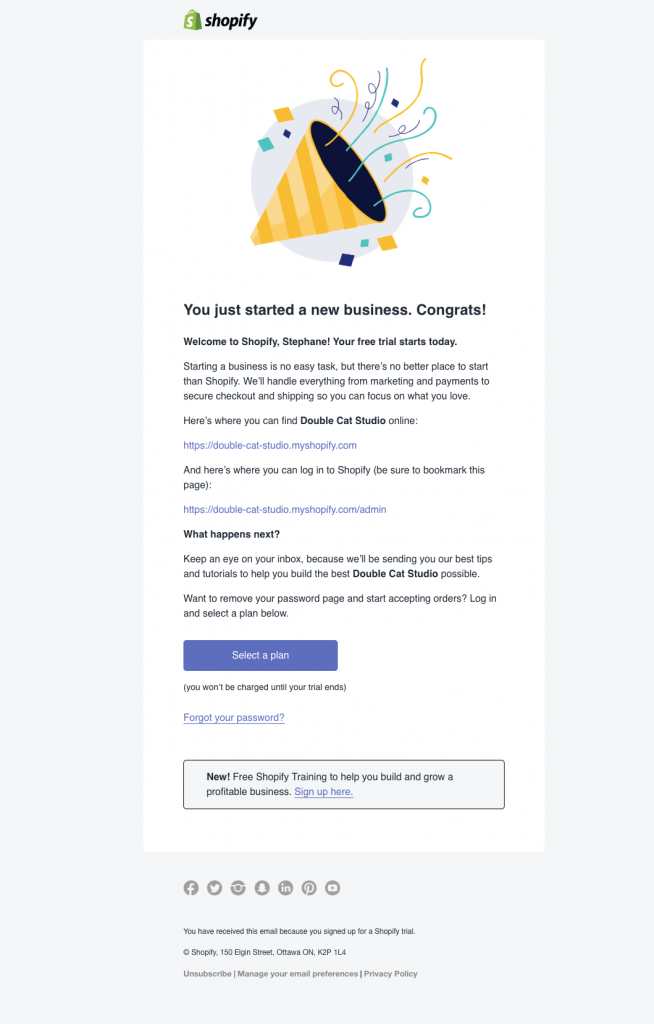
The first impression you have on a new subscriber counts. This may sound pretty intuitive, but 83% of brands still fail to make a first impression, let alone a positive one. A well-designed email is what you need if you don’t want to be a part of this 83%. Why? Because the impressions you leave while converting a lead to a customer aren’t enough: as a SaaS company, you need to generate long-term subscribers, and that means creating engaging emails that are personalized and get your message across.
A multinational e-commerce company, Shopify leaves a perfect first impression on its new customers. The email is personal: directly addressing the customer by their first name, and including a lot of “you” and “your”s. There is an inspirational quote at the bottom of the email, signaling what the new user can do with the service they are now paying for. But most importantly, there are several links leading the reader back to the website: a design logo button, links to webinars, blogs, and guides, and login URLs are all included.
SurveyMonkey’s Welcome Email

Another welcome email to make our list of inspirational emails is the one sent by SaaS company, SurveyMonkey. The subject line is a warm welcome, there is a bright call to action button right in the middle, and the design colors match the branding. The possibilities that are offered are written clearly and concisely in one sentence per block. Again, the email does a good job in leaving a good first impression and creating engaged users.
Zapier’s Service Update Email

We cannot stress it enough: you need to emphasize your new features to keep your subscribers. Users are constantly looking for reasons to renew their subscriptions, and you shouldn’t leave it to them to find the new additions. Update emails make sure that your new features don’t go unnoticed, proving to readers that your brand is constantly evolving and improving itself.
Zapier’s email can be described as part newsletter part service update: they tell the user how much they have improved (more than 10 improvements!) and provide them with a clear summary button. There are one-sentence descriptions of the additions, but nothing more.
Zapier also knows the features that the users care about and provides information about the updates relevant to them. A short, personalized email like this one is enough to update your users.
LinkedIn’s Personalized Email

LinkedIn addresses the issues specific to its customer, another strategy to make your email personal. The design is consistent with LinkedIn’s general design with the color patterns and symbols, and the word choice is appropriate: using action words like “grow,” “analyze” and “identify” gets the customer going.
Flock’s Welcome Email
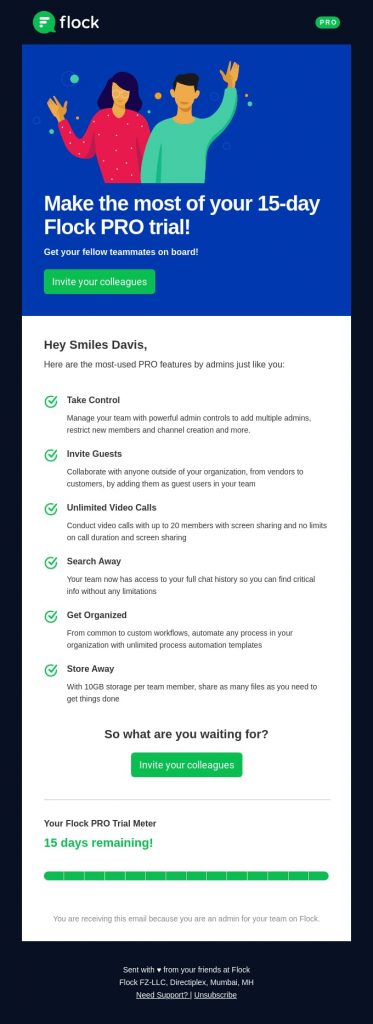
This welcome email for a free trial follows a bit of a different strategy: it directly leads the user to the premium version of Flock’s service, giving six different reasons as to why they should sign up for it. The explanation at the start is also targeted to the reader, mentioning “admins just like you.” Even though such an advertising welcome email is risky, it can get your free-trial users, who are simply leading in the consideration stage, down to the purchasing stage more quickly.
Again, there are two calls to action buttons that are both at the beginning and end of the email, giving the reader two opportunities for engagement.
- An important note: you really shouldn’t put these buttons all over your emails. A button after each sentence is not the way to go. Instead, one or two buttons are sufficient, so that you don’t overwhelm your reader.
DigitalMaas’s Verification Email

Verification emails are crucial: you have to make sure that your campaigns, newsletters, and update emails are reaching your target audience. DigitalMaas keeps the email to the point by welcoming the new customer and asking for their verification.
Proof’s Activation Email
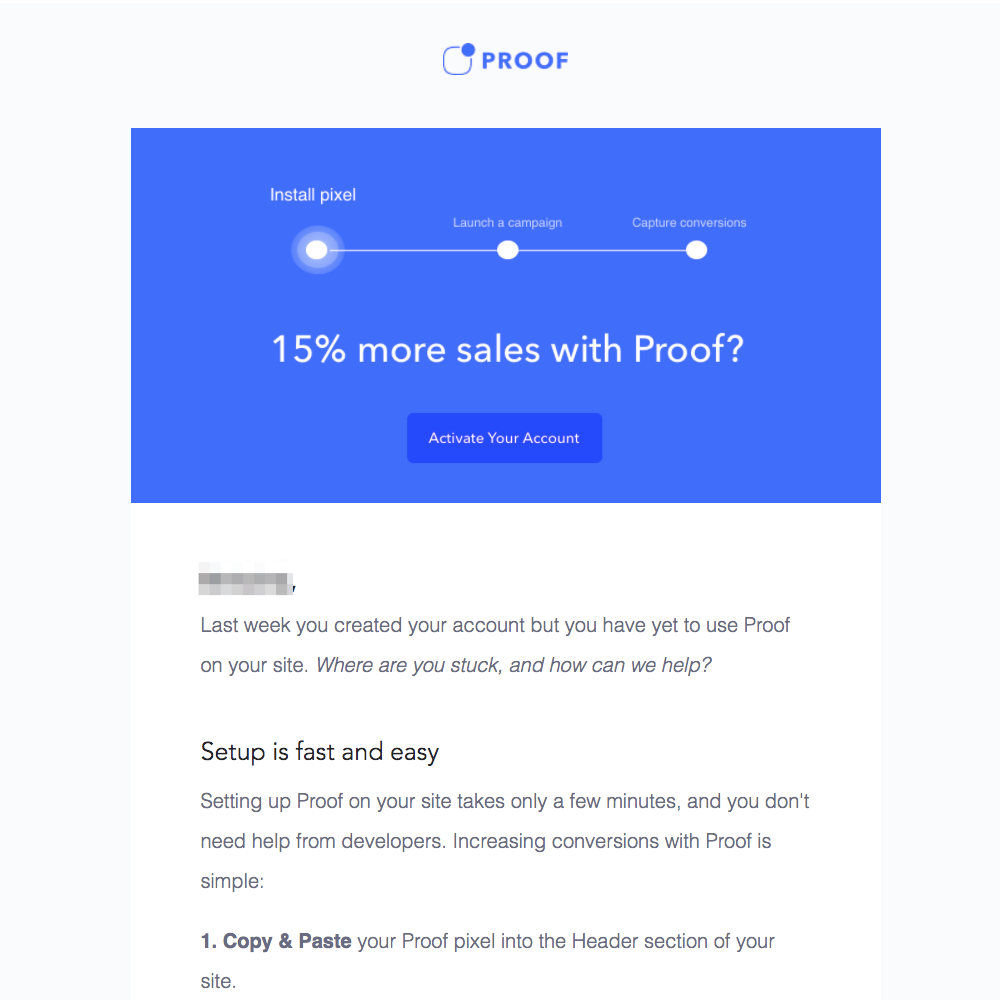
Some of your users will create accounts, they will show interest in your services, but at a certain point, they’ll just stop engaging. You have to remind them about your brand, and you have to do this by sounding helpful, not desperate. Try asking them how you can improve their experience like Proof did with their activation email.
- “How can we help?” is a great question to show users that you care.
- Giving them a step-by-step guide to the activation process is even better, especially if you talk about how easy it is by saying that it takes “less than 30 minutes!”
- Proof also includes data to show what the inactive user is missing out on, overall creating an email that makes use of almost every strategy there is.
Duolingo’s Winback Email

Infamous for its constant winback messages, Duolingo may be the prototype when it comes to re-engagement emails. Just like Teespring, Duolingo wanted to dive deeper into the readers’ emotions with the symbol of their brand: Duo the bird. The email includes only four sentences, it’s clear and concise like all the others, and even more importantly, it is consistent with the branding. Again, getting your customers used to your branding is crucial if you want them to think of your services when you send them a notification.
Front’s Winback Email

Front follows a different strategy: their email is much longer, with a more implicit CTA link. So how is it still effective? Remember, 45% of customers that receive a winback email from your brand will open your future emails, becoming more likely to engage with your brand again. This particular winback email:
- Shows the inactive customer palpable reasons as for why they should reconsider: the “we have improved” rhetoric is used for this purpose,
- Gives the reader another free trial, so that they can see the improvements themselves,
- Tells the reader that it’s easy to clear their account to start fresh–one of the reasons why the user may have been unsure about re-opening their account.
GetBusy’s Product Update Email

Another great feature update comes from Getbusy. Blog posts or landing pages dedicated to your new features may emphasize your improvements, but this email reaches a more specific audience that is likely to look at these features in more detail (as I’ve said before, the people on your email list are either interested leads or subscribers looking for reasons to keep their subscription.)
This e-mail addresses this group perfectly: it both explains the features, and the usage of the feature in 4 easy (and colorful!) steps, and gives the reader a chance to engage with the brand by asking questions.
Asana’s Newsletter

Asana tells the reader that they know what their customers are dealing with–and that as a brand, they are trying to cater to their needs. The face of the Head of Community makes the email feel personal, adding to the empathetic vibe of the email.
The email focuses on two different blog posts (and these types of emails can be helpful if you want to drive traffic to your posts.) They are summarized in 1-2 clear sentences, and they have attractive designs that are consistent with the branding. The two purple CTA buttons are likely to get attention in an email like this one.
Campaign Monitor’s Newsletter Email

It’s expected for Campaign Monitor to have an exemplary newsletter email as an email marketing software brand.. Their newsletter does the trick because:
- It leads the reader to infographics or lists, which are all easy to digest content types,
- It talks about partnerships with other brands that may sound familiar to the reader, which in turn, gets them interested,
- It includes several (but different!) CTA buttons leading the reader to the website,
- It summarizes each recent blog post in one easy sentence,
- It uses colors and designs that are easy on the eye.
Wistia’s Welcome Email

Wistia’s welcome email may be one of the most creative ones on this list. A brand can’t get more personal: the company has written a short poem to tell the new customer about their services’ features.
Adding a couple of emoji-like symbols that represent the brand to the top also increased the warm welcoming effect of the message. It’s quite catchy and memorable, too.
If this warm tone is consistent with your brand’s tone and positioning, you may want to consider writing emails that are creative like this one.
Shopify’s Newsletter Email

Webinars are excellent opportunities for your brand to give the audience a sense of your business’s personality and put a face behind the brand — something that’s not easy to do via text. However, your leads or customers aren’t going to follow each live event you host, so you have to remind them.
Shopify reminds people of, firstly, their webinar, and then of the other events that they are hosting. Again, the smallest detail makes all the difference: “directly from our home to yours” creates an intimate bond with the reader.
Chanty’s Re-Engagamement Email

I couldn’t include it on this post, but Chanty’s email was actually featuring a GIF of the dog crying under the rain (which seems to be a popular way of appealing to the reader’s emotions.)
The email has a clear CTA button, taking the reader back to where they had left, giving them “at least three reasons” why they should.
SaaS Email Marketing Metrics You Need To Track
ROI
Return of Investment (ROI), in general, is the measure to assess the profitability and efficiency of an investment. As an email marketing metric, ROI is the measure of the profitability of email marketing. In other words, you can think of ROI as dollar for dollar: How much you, as the business owner, spend on an email, and how much you gain in return. Email marketing has one of the highest ROIs, with an average of $44 gained to $1 spent, across all businesses and marketing strategies. Therefore, tracking and understanding your ROI is vital to enhancing your email marketing.
To analyze ROI, you need to be aware of how much you spent and how much you earned through email marketing. By looking at these figures, you can have a general idea of what your current ROI is and how you can improve it. If you have a low ROI, you need to consider revising your email marketing strategy and identifying any possible problems in your marketing that could cause this. If you have a high ROI, you should also check the possible areas that help you to have a high ROI. By analyzing different email marketing metrics, you can understand your ROI and take data-driven actions.
ROI = (Gain – Spent) / Spent
Open Rate
Tracking open rates can help you to distinguish between “active” and “passive” customers and give you an idea about your strengths and weaknesses in your email marketing. In 2020, the average open rate for B2B businesses was 21.3%, which was less than in previous years. This doesn’t mean that email marketing is coming to an end. Historically speaking, a decrease at the open rate is most of the time followed by an increased period. Therefore, tracking and improving your open rate should be one of your priorities.
Open rate is also crucial to understand whether the message you want to convey through emails is successfully passed to your customers. If you can collect data about open rates, you can make effective plans to how to improve your open rate and ultimately your whole marketing strategy.
Email open rate = (Number of Emails Read / Number of Delivered Emails) x 100
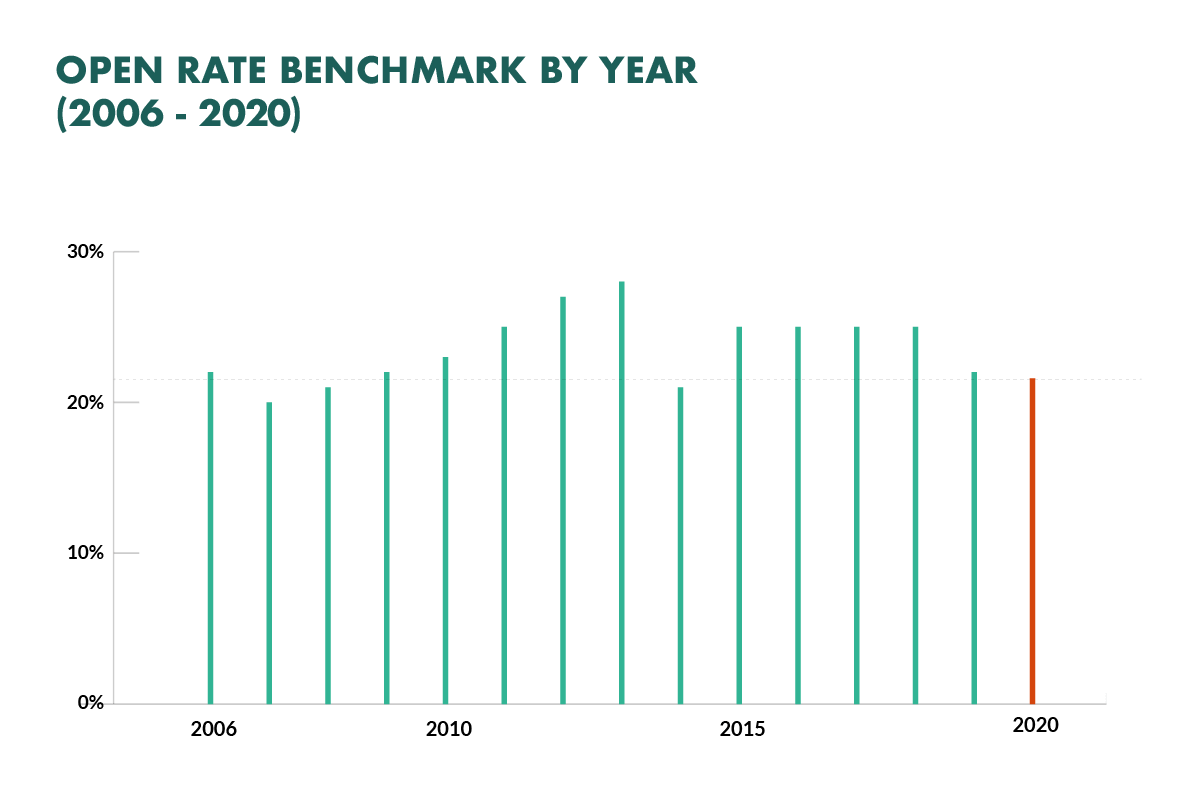
Click Rate
Click rate is the percentage of successfully delivered emails that got one or more clicks. It is essentially the email marketing metric that helps you to understand whether your customers find your emails useful/relevant enough to click through. If you are not offering them anything (can help over a problem, a promotional offer, new information or a feature, etc.), your click-through rate will be below.
To have a better click rate, you need to create content that can appeal to your customers. This doesn’t necessarily mean that you need to change your content. You can achieve a high click rate by just changing the subject line or the sender name. These can help your customers to understand the context and sender of the email instantly, without spending time and effort, which are things that can directly affect your click rate.
Other ways to improve your click rate are the structure and visuals of your emails. If your emails contain distracting images and unnecessary sentences, your customers will not try to solve what your emails want to say and will leave the email without clicking on any link. Likewise, avoid using phrases like “click here” for links because they are vague and unclear. Customers tend to click on links that are smoothly embedded in words/phrases/sentences that they cannot understand. Therefore, while constructing your emails, you should consider different aspects of an email and create an email that is both visually and contextually appealing.
Also, regularly checking your subscribers’ list can make a huge difference in your click rate. Keeping track of hard bounces (failed email addresses) and soft bounces (temporarily unavailable email addresses) can help you to clean and revise your subscriber list and help you to improve your click rate.
Average Click Rate = (Contacts Who Clicked on a Link in Your Email / Total Number of People Who Received the Email) x 100
Email List Growth Rate
As the name implies, email list growth is the rate at which your subscriber list is growing. This is one of the metrics that can help you to understand how many of your customers you are reaching and how many of you cannot reach. The email list growth rate also accounts for the unsubscribers, which are as important as new subscribers.
Unsubscriptions can give you valuable insights into your email marketing strategy. To track and understand why your customers are unsubscribing from your mailing list and who these subscribers are, you can get help from HockeyStack. With its detailed reports and useful visuals, HockeyStack can easily help you identify your weaknesses and enhance your marketing strategies.
Even though unsubscription is not a favorable action, it is very natural to experience some. There will always be some subscribers that will not engage with the emails you are providing. The important thing is continually expanding your email list so that the number of new subscribers is always exceeding the number of unsubscribers: Focus your energy to find new loyal subscribers, engage with your current subscribers, and provide valuable content for your customers.
Email List Growth Rate = ((Number New Subscribers – Number of Unsubscribers) / Total Number of Email Addresses on Email List ) x 100
Bounce Rate
Bounce rate is the metric that measures how many of your subscribers didn’t receive your emails. Bounces can occur more frequently than you think because bounces are not just failed email addresses, but they also contain temporarily unavailable email addresses.
Soft bounces are bounces that refer to temporarily unavailable email addresses, meaning that they track temporary problems with email addresses. These can happen when the recipient is on vacation or when the mailbox of the recipient is so full that they cannot look at emails. Hard bounces, on the other hand, refer to failed email addresses, which have permanent problems. When the recipient’s email address is wrong or the email address is closed, a hard bounce will occur.
Tracking and analyzing hard and soft bounces are crucial to understanding the quality of your subscribers’ list and its growth. If you have a high rate of hard bounces, you need to check your list for old, fake, or error email addresses. To minimize these bounces, you can require a double opt-in, which helps you to verify your subscribers’ email addresses and confirm their email subscription. This can significantly lower your bounce rate because it helps you to refine your email list and eliminate any passive subscribers.
Bounce Rate = (Bounced Emails / Sent Emails) x 100

Share Rate
Share rate (email sharing rate) measures how many times your recipient shared your email through the “share this” button on your email.
While share rate can show you the engagement level of your emails, it also gives you an idea of how many potential subscribers you are reaching. This is especially helpful to understand the new additions to your email list and strategize to find new loyal subscribers.
The share rate metric can be used on its own. However, it is mostly used to set helpful benchmarks for the future with a combination of other email marketing metrics. For example, combining click rate and share rate can give you an idea about the quality of your content and the ways your subscribers are engaging with your emails. Similarly, combining share rate with email list growth rate can help you to improve your email list and attract new subscribers.
Share Rate = (Amount of clicks on “share this” button / Total Amount of Delivered Emails) x 100
Unsubscribe Rate
The unsubscribe rate is the rate at which your subscribers unsubscribe from your mailing list. It is one of the simplest and easiest email marketing metrics to track. The Unsubscribe rate can be especially helpful to identify your weaknesses and strengths in your email marketing campaigns (visuals, content, structure, etc.).
While the high number of unsubscribers can indicate a weakness, it can also indicate that you are effectively refining your email list. For example, if the unsubscribe rate is increasing while the bounce rate is decreasing, it is actually a positive outcome because this means that your email list is clear from subscribers that are not engaging with your content.
In addition, offering your subscribers the opportunity to unsubscribe to your mailing list is an effective marketing strategy to gain the trust of your customers. With this opportunity, you can both show your appreciation to your customers and let them know that you care about their decisions.
Unsubscribe Rate = (Number of unsubscribed / Total Number of Emails Delivered) x 100
Conclusion
Email marketing is an essential strategy if you’re trying to reach out to your customers in a more personalized manner. If I were to give you the ingredients of the perfect marketing email, I would summarize all of the techniques used above as:
- Make your email personal.
- Make the design consistent with your branding.
- Don’t overwhelm the reader with long paragraphs.
- Have CTA buttons, but not too many.
- Leave good first impressions.
- Have good timing
The most important thing to do, however, is to track your email marketing efforts with the help of a tool that can not only give you insights into the open rate and bounce rate of your emails, but also combines your marketing data with sales information to help you understand exactly how you can improve your ROI.
Yes, it is. To this day, email marketing has the highest ROI compared to other marketing strategies.
Email marketing is not expensive, but it requires substantial effort to build an email list & an engaged audience.



